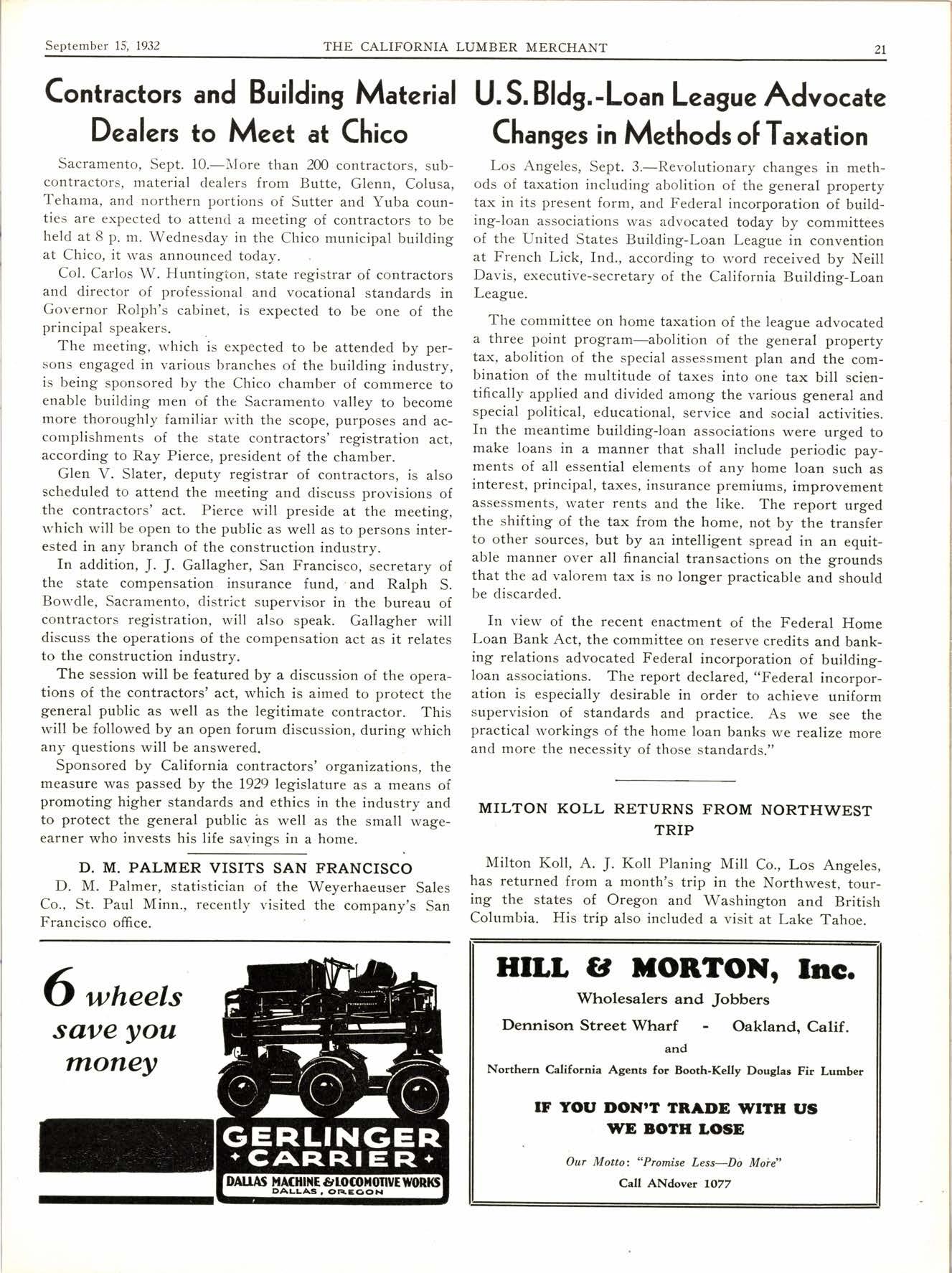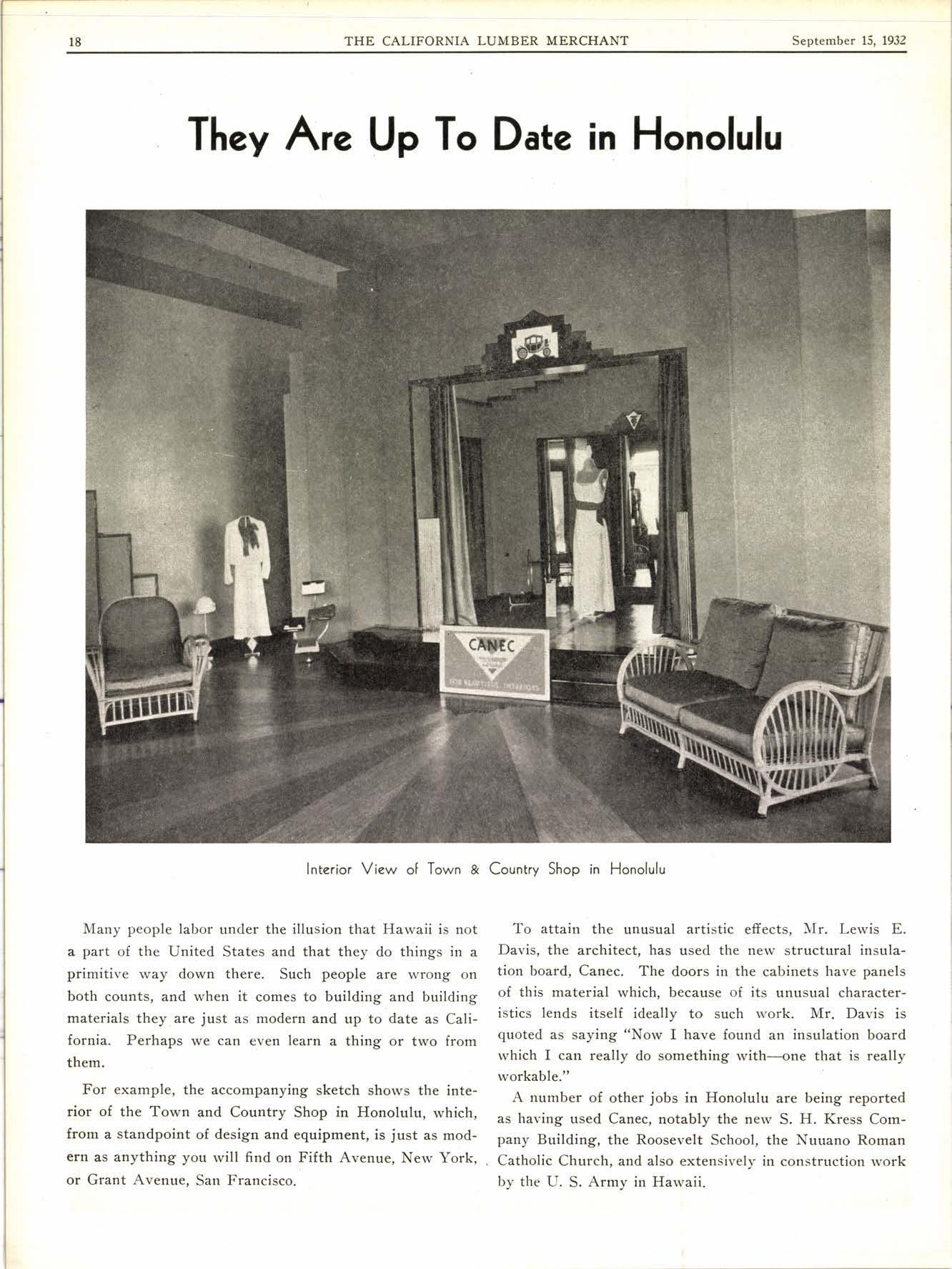
3 minute read
\(/ashlngton the Leading Lumber W. F. Baird Appointed General Producing State Sales Manager
August 26.-Washington in 1930 produced 21 per cent of all the lumber cut in the United States, 86 per cent of all the shingles manufactured and 32 per cent of all the wood lath. Washington has been the leading lumber-producing state since 1905 with the single exception of 1914 when Louisiana was first by a narrow margin.
According to the last biennial Census in 1929, the number of wage-earners engaged in the sawmills and logging operations in Washington was 58,570, or 51 per cent of all the rvage-earners of the state. The wages paid to this industry of $83,753,4O2 were 52 per cent of total payrolls of the state and its value of products, or $262,621,468, was 33 per cent of the total value of products of all the industries of Washington.
Not only is the lumber and timber industry and shingle mahufacture of overwhelming importance in Washington. Planing mill products in establishments not connected with sawmills, show 3,600 wage-earners receiving $4,472,917 in wages and report $23,463,3M as value of products; the paper and wood pulp industries report 5,168 wage-earners; $7,316,216 in wages paid and $47,094,096 as value of products. Value of products in the u'ood preserving industry is given as more than $8,@0,N0 in 19?9.
The year 1926 was the peak year in lumber production in Washington, as reported by the Census Bureau, a total of 7,546,239,000 board feet beiug recorded. In l9D, the lumber cut was 7,302,063,0N feet as reported by 569 mills and in 1930 the production was 5,502,129,W leet by 4D mills. Of the 193O total, 70 per cent was Douglas fir; 17 per cent hemlock; 6 per cent Ponderosa pine ; the rest mostly spruce and cedar. Preliminary report for 1931 by the Census Bureau shows decline of 29 per cent in lumber production in the large mills of Washington and Oregon as compared with 1930.
Washington is preeminently a state of large sawmills. In 193O, of the 72 rr.ills in the United States reported by the Census Bureau as each cutting 50,000,000 feet or more, 30 were in the state of Washington. These 30 cut 42 per cent of the total lumber output of the state. Mills cutting between 15,000,000 and 50,000,000 feet each produced another 46 per cent of the total. Only 12 per cent was produced in the medium-sized and small mills of the state. This contrasts with the leading lumber-producing state of the South, Louisiana in 1930, where only one mill is reported as cutting over 50,000,000 feet, and where mills cutting less than 15,00O,000 feet each, produced 42 per cent of the total cut.
An unusually large proportion, nearly 58 per cent, of the lumber sales by the sarvmills of Washington is marketed through wholesalers and commission houses including branch wholesale establisliments, according to a Census Bureau report f.or 7929; about 17 per cent is exported; about 1 I per cent is sold to retailers ; only 3.3 per cent direct to manufacturers in the wood-consuming industries and 3.1 per cent to railroads and public utilities.
The state of Washington consumed in 1930 a total of 1,,269,374,m feet of lumber, according to the U. S. Forest
The Michigan-California Lumber Company, Camino, Calif., announces the appointment of W. F. Baird as General Sales Manager which became effective September 1. Mr. Baird will contact the trade personally and in this connection he will make a trip East in the near future. Percy McNie will continue his duties as Sales Manager rvith headquarters at Camino. In order to have a balanced stock of sugar pine for the fall and winter, the company are operating their Pine Grande mill for a short season.
Pamphlet Shows Use o[ Redwood in Monterey Type Apartment
A beautifully illustrated pamphlet showing the use of California Redwood in an apartment of the Monterey type, designed by Jar:res N. Conrvay and built by Guy Harrison at West'ivood Village, Los Angeles, was recently issued by the California Redwood Association. The pamphlet is headed "IJnquestionably the Trend is Back to Wood".
Lumberman Enters New Field
H. W. Gustafson, who was for many years with the Coos Bay Lumber Co., has gone into the restaurant business, and is already making good in this line. Henry's place is located on the Stockton-Tracy highway at the Tracy side of the San Joaquin River bridge, and he will always be glad to see any lumbermen who find it convenient to drop in.
New Yard at Lalayette
i
Stuart C. Smith, rvho has been associated with the Coos Bay Lumber Co. for the past 15 years, and who has recently been covering the northern counties territory as salesman for this company, has started a yard at Lafayette, Contra Costa County. The new yard will be known as the Lafayette Lumber & Supply Co.
Service, which was less than one-fourth of the production of the state. Of this consumption, only about 10 per cent came from other states ancl less than one per cent was imported, mostly from Canada, the Canadian figures covering all sawed lumber imports reported in board feet.
Of Washington's lumber distribution, about 17 per cent is exported.' Of the domestic distribution, somewhat less than one-fourth remains in the state; about 18 per cent goes to California by rail and water; approximately 13 per cent to the mid-western group of Illinois, Iowa and Minnesota, and about 23 per cent to the northeastern states of New York, Nerv Jersey, Massachusetts and Pennsylvania.









